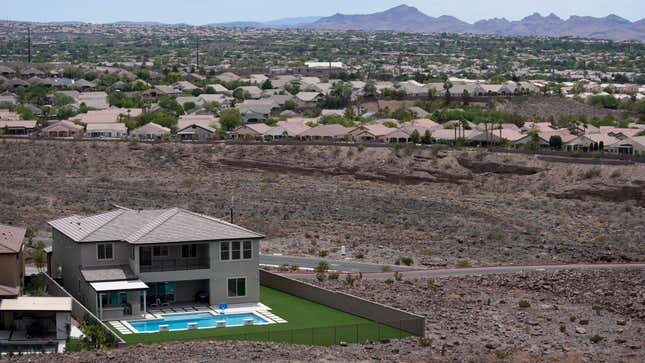
Las Vegas may be a city of excess—but no longer when it comes to swimming pools. Officials voted this week to cap the size of home swimming pools in Clark County, Nevada, where Vegas is located, in an attempt to conserve water in the face of the region’s punishing drought.
The new regulations won’t retroactively affect the county’s 200,000 home swimming pools. But after September 1, new pools can have a maximum size of only 600 square feet (55.7 square meters). That’s still a pretty big pool: it’s roughly the same size as a three-car garage, and the average size of home pools in Clark County is just 470 square feet (43.7 square meters). The restrictions also won’t have an impact on new commercial pools in hotels, water parks, and other businesses. But these new standards could help rein in water wastage by—you guessed it—the super-rich.
“We have a lot of pools that exceed 3,000 square feet… and a lot of stuff seen in these new homes is not even used for recreation. It is all for aesthetic,” Las Vegas Valley Water District General Manager John Entsminger explained during a meeting of the Water District’s Board of Directors. “The increase in ‘pool-scaping’ definitely threatens to erode our efficiency gains in conservation.”
Vegas is on the front line of the West’s water crisis. About 90% of Nevada’s water supply is taken from the Colorado River, and most of that is drawn from Lake Mead—which has hit historic low after historic low this year thanks to drought and overuse. Officials at the meeting reminded the crowd that Lake Mead could hit close to “dead pool” levels—the point at which the Hoover Dam can no longer produce hydroelectricity—by 2026 if drought conditions continue.
And in the face of these dire conditions, extravagant pools do seem tone-deaf, at the very least. It’s easy to find examples of super-expensive, super-wasteful pools in Vegas. The city’s biggest private pool, owned by a real estate tycoon (who else), holds a truly wild 180,000 gallons of water. Pool-themed home improvement shows (yes, they exist) like Pool Kings, Supersize My Pool, and Cool Pools have featured plenty of outrageous Las Vegas pools. A quick spin on real estate sites will show you plenty of pricy homes for sale with luxuriously large pool setups. (If the climate apocalypse is really your thing, someone is even selling a house with an underground doomsday bunker—that has its own pool.)
“We have seen a proliferation in excess of one thousand, two thousand or three thousand square feet,” Bronson Mack, the public information officer for the Southern Nevada Water Authority, said at Tuesday’s meeting. “There is one right now that is 5,000 square feet that is looking to be permitted. I don’t know about you, but that is two times the size of my residential home.”
Unsurprisingly, the pool industry was not happy with the new restrictions. “Our industry is being unfairly targeted because it’s easy to show pictures of lavish swimming pools saying ‘That’s the problem,’” Dustin Watters, the manager of a local pool and spa business, said during the water district meeting.
Restricting the size of home swimming pools—especially without any restrictions on commercial pools—isn’t exactly going to fix decades of water mismanagement combined with the growing impacts of climate change. Still, every drop counts in places like Las Vegas—and restricting pool sizes could help a little. An analysis of more than 43,000 residential swimming pools in Los Angeles found that an estimated 2,000 acre-feet of water—the amount needed to cover a vertical acre in a foot of water, equivalent to about 326,000 gallons—are lost each year due to evaporation from uncovered pools. The average pool size in Vegas is actually a little bigger than the ones measured in LA, and there are more pools in Clark County than were covered in this analysis.
The new pool restrictions are keeping in line with a number of aggressive water reforms Las Vegas has made in recent months. This year, the city began enacting a new state law banning “non-functional grass”—grass whose only purpose is to enhance the appearance of roads and sidewalks—by ripping it out and replacing it with landscaping better designed to withstand arid weather conditions. (One square foot of grass landscaping alone uses 73 gallons of water each year; desert landscape needs only 18 gallons.)
“For having a reputation as a city of excess, we’re actually one of the most water-efficient cities in the world,” John Entsminger, the general manager of the Southern Nevada Water Authority, told CBS in June.
What happens in Vegas may usually stay in Vegas, but here’s hoping some of these water conservation measures find their way elsewhere.